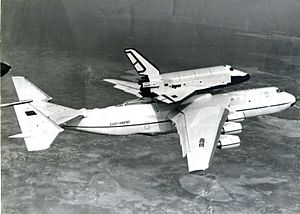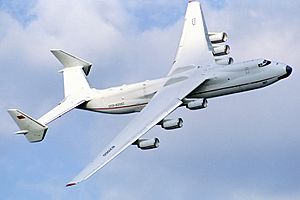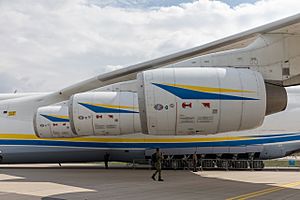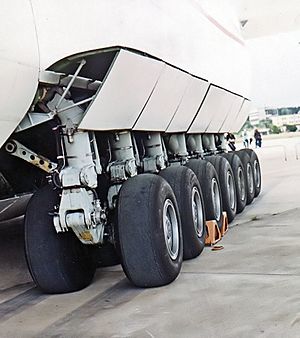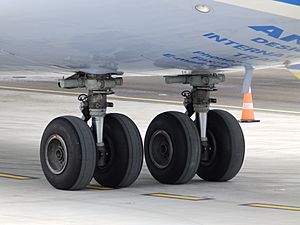Antonov An-225 Mriya facts for kids
Quick facts for kids An-225 Mriya |
|
|---|---|
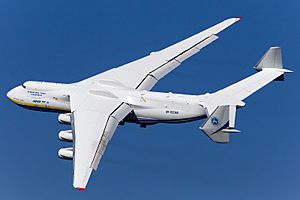 |
|
| The An-225 in its 2009–2022 livery | |
| Role | Outsize cargo freight aircraft |
| National origin | Soviet Union (Ukrainian SSR) |
| Design group | Antonov |
| Built by | Antonov Serial Production Plant |
| First flight | 21 December 1988 |
| Status | Destroyed 27 February 2022 |
| Primary user | Antonov Airlines |
| Produced | 1985 |
| Number built | 1 |
| Developed from | Antonov An-124 Ruslan |
The Antonov An-225 Mriya (which means 'dream' or 'inspiration' in Ukrainian) was an amazing cargo aircraft. It was designed in the Soviet Union by the Antonov company. This giant plane was built to carry really big and heavy things.
Only one An-225 was ever fully built. It was the heaviest aircraft ever made and had the largest wingspan of any plane in active service. People all over the world loved seeing it because of its incredible size and unique look. Sadly, the only An-225 was destroyed in 2022 during a conflict in Ukraine. There are now plans to rebuild it.
Contents
The Mriya's Journey: From Space to Super Cargo
How the An-225 Was Born
Work on the An-225 started in 1984. The Soviet government needed a huge plane to carry parts of their space rockets and the Buran space shuttle. This was similar to how the United States used a special plane to carry its space shuttle.
The designers at Antonov decided to make a bigger version of their existing Antonov An-124 Ruslan cargo plane. They made the An-124 longer and added two more engines, bringing the total to six! They also changed the tail to a special "twin tail" design. This helped the plane fly steadily even when carrying huge items on its back.
First Flights and Public Appearances
The An-225 took its first flight on December 21, 1988. It made its first public appearance outside the Soviet Union at the 1989 Paris Air Show. There, it showed off by carrying the Buran space shuttle on its back! A year later, it flew at the Farnborough Air Show.
Only one An-225 was completed. It could carry super heavy items up to 250,000 kg (550,000 lb) inside. It could also carry items up to 200,000 kg (440,000 lb) on its upper body. These external items could be as long as 70 meters (230 ft)!
The Second An-225
A second An-225 was started in the late 1980s. However, work stopped when the Soviet Union broke apart. For many years, it sat unfinished. Later, people realized there was a big need for such a large cargo plane. So, there were plans to finish the second An-225.
By 2016, the second aircraft was about 60–70% complete. Finishing it would cost a lot of money, but many hoped it would one day fly.
Design: What Made the Mriya So Special?
The An-225 was a truly unique plane. It shared many features with its smaller cousin, the An-124. But the Mriya was much bigger!
Engines and Wings
The An-225 had a longer body and cargo area. Its wings were also made bigger to hold six powerful Progress D-18T turbofan engines. That's two more engines than the An-124! These six engines gave it incredible power.
Landing Gear and Cargo Hold
This giant plane needed a special landing system. It had 32 wheels, and some of them could steer. This allowed the An-225 to turn on a runway that was only 60 meters (200 ft) wide.
The An-225 also had a "kneeling" nose gear. This meant the front of the plane could lower itself. This made it much easier to load and unload huge cargo. Inside, there were four cranes that could lift up to 5,000 kg (11,000 lb) each.
The cargo hold was enormous! It was 43.35 meters (142 ft) long, 6.4 meters (21 ft) wide, and 4.4 meters (14 ft) tall. That's longer than the first flight of the Wright brothers! It could hold up to 80 standard cars or 16 large shipping containers. It could carry up to 250,000 kg (550,000 lb) of general cargo.
The An-225 was built for long flights. Even when fully loaded, it could fly non-stop across huge distances, like from New York to Los Angeles.
Operational History: The Mriya in Action
Early Years and Commercial Use
From 1988 to 1991, the An-225 was mainly used to carry the Buran space shuttles. After the Soviet Union ended, the Buran program stopped. The An-225 was then put into storage in 1994. Its engines were even removed to be used on other planes.
However, by the late 1990s, there was a clear need for a plane even bigger than the An-124. So, it was decided to bring the An-225 back to life!
A New Purpose: Heavy Cargo Transport
The An-225 was given new engines and updated technology. It began flying again for Antonov Airlines, a company that specializes in heavy cargo. The Mriya became famous for carrying things that no other plane could.
It transported huge items like 130-ton generators, long wind turbine blades, and even diesel locomotives. It also helped international relief groups by quickly delivering large amounts of emergency supplies during disasters.
The An-225 made its first commercial flight on January 3, 2002. It carried 216,000 prepared meals for military personnel in Oman. This huge load weighed 187.5 tons! It also helped transport military supplies for the Canadian and U.S. governments. Shipping cargo by An-225 was expensive, costing hundreds of thousands of dollars for a single flight.
In 2009, the An-225 got a new paint job: blue and yellow. These colors matched the Ukrainian flag. This made the An-225 a "winged ambassador" for Ukraine around the world.
When the COVID-19 pandemic hit in 2020, the An-225 helped deliver medical supplies from China to many countries. This showed how important it was for global logistics.
Records: A True Record Breaker
The An-225 was a champion at breaking records.
- On August 11, 2009, it carried the heaviest single item ever flown: a generator weighing 189,980 kg (418,834 lb).
- It also carried a total payload of 247,000 kg (544,540 lb) on a commercial flight.
- On September 11, 2001, it carried four main battle tanks, a record load of 253.82 tons of cargo.
- On June 11, 2010, it carried the world's longest piece of air cargo: two 42.1-meter (138 ft) long wind turbine blades.
- In 2012, it hosted the highest altitude art exhibition in the world, at 10,150 meters (33,300 ft) above sea level!
In total, the An-225 set 240 world records, which is more than any other aircraft!
Destruction: A Sad End and Hopes for the Future
The Battle of Antonov Airport
The An-225's last commercial flight was in early February 2022. It delivered COVID-19 test kits from China to Denmark. After that, it returned to its home base at Antonov Airport in Hostomel, Ukraine, for maintenance.
On February 24, 2022, a conflict began in Ukraine. The airport became a target. Ukrainian authorities quickly banned civilian flights. During the Battle of Antonov Airport, the runway was damaged.
On February 27, it was confirmed that the An-225 had been destroyed in its hangar. Several other aircraft in the same hangar were also damaged or destroyed.
Plans to Rebuild
The Antonov company and the Ukrainian government announced plans to rebuild the An-225. They estimated it would cost over $3 billion and take more than five years. They hope that the country responsible for the damage will cover these costs.
Aftermath and Future
After the conflict, drone footage showed the destroyed Mriya. The front part of the plane was completely burned, but parts of the wings were still there.
There are ongoing discussions about how to rebuild the An-225. One idea is to use parts from the wrecked plane and combine them with the unfinished second An-225. However, many of the original parts were made in the 1980s and are no longer produced. Engineers estimate the cost to be around $350–500 million.
Despite the challenges, Ukrainian President Volodymyr Zelenskyy announced his intention to complete the second An-225. This would replace the destroyed aircraft and honor Ukrainian pilots. In November 2022, Antonov confirmed plans to rebuild the aircraft.
Former operators

 Soviet Union Antonov Airlines for the Soviet Buran program. The company and aircraft later became part of Ukraine.
Soviet Union Antonov Airlines for the Soviet Buran program. The company and aircraft later became part of Ukraine. Ukraine Antonov Airlines for commercial flights from 2002 until its destruction in 2022.
Ukraine Antonov Airlines for commercial flights from 2002 until its destruction in 2022.
Variants
- An-224: An early idea for the plane that would have had a rear cargo door. It was never built.
- An-225: The actual plane that was built. Only one was completed, and a second was started but not finished.
- An-225-100: This was the name given to the An-225 after it was updated in 2000. It got better communication and navigation systems.
- An-325: A proposed even larger aircraft with eight engines. It was designed to launch spacecraft into orbit but was never built.
- AKS: A very ambitious design that would have used two An-225 bodies joined together. It was meant to carry a spaceplane but was considered too difficult to build.
Specifications
Data from Antonov's Heavy Transports, and others
General characteristics
- Crew: 6
- Capacity: 190 tonnes (420,000 lb)
- Length: 84 m (275 ft 7 in)
- Wingspan: 88.4 m (290 ft 0 in)
- Height: 18.1 m (59 ft 5 in)
- Wing area: 905 m2 (9,740 sq ft)
- Aspect ratio: 8.6
- Empty weight: 285,000 kg (628,317 lb)
- Max takeoff weight: 640,000 kg (1,410,958 lb)
- Fuel capacity: more than 300,000 kilograms (660,000 lb) 375,000 L (82,488 imp gal; 99,065 US gal)
- Cargo hold: volume 1,300 m3 (46,000 cu ft), 43.35 m (142.2 ft) long × 6.4 m (21 ft) wide × 4.4 m (14 ft) tall
- Powerplant: 6 × Progress D-18T turbofans, 229.5 kN (51,600 lbf) thrust each
Performance
- Maximum speed: 850 km/h (528 mph; 459 kn)
- Cruise speed: 800 km/h (497 mph; 432 kn)
- Range: 15,400 km (9,569 mi; 8,315 nmi) with maximum fuel; range with 200 tonnes payload: 4,000 km (2,500 mi)
- Service ceiling: 11,000 m (36,000 ft)
- Wing loading: 662.9 kg/m2 (135.8 lb/sq ft)
- Thrust/weight: 0.234
See also
 In Spanish: Antonov An-225 para niños
In Spanish: Antonov An-225 para niños
- MAKS (spacecraft)
- State Space Agency of Ukraine
- TTS-IS
- Aircraft related to this one
- Similar aircraft
- Airbus Beluga
- Airbus BelugaXL
- Beriev Be-2500
- Boeing 747-8F
- Boeing Dreamlifter
- Boeing 747 Shuttle Carrier Aircraft
- Lockheed C-5 Galaxy
- Myasishchev VM-T
- Scaled Composites Stratolaunch, the largest wingspan (117 meters) on any aircraft which has flown (2019)
- Lists related to this aircraft
- List of large aircraft
- List of military aircraft of the Soviet Union and the CIS


